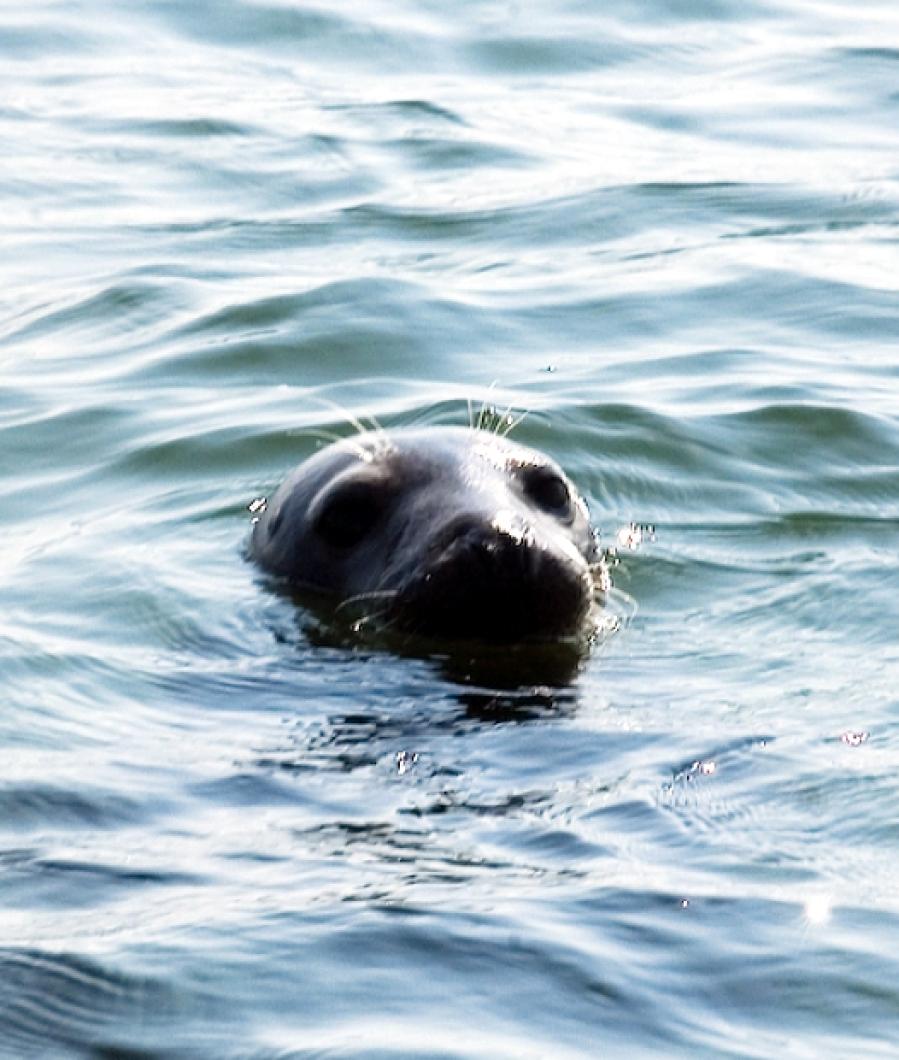An abundant food supply, safe habitat and management protection that began years ago has contributed to the resurgence of seals in Island waters.
Gray and harbor seals are back. Though marine experts at the federal level don’t have actual numbers, there have been many reports this summer of seals around the Island. In short, not all bathers at the beach are humans.
“In the last four or five years we have seen five or six seals a day,” said Dennis Arnold, beach patrol director for the town of Edgartown. “This summer we have seen two dozen seals a day, at least. They go up and down the beach from Norton Point all the way to Crackatuxet. They swim back and forth. They pop up amid the swimmers. The pups go body surfing in the break,” he said.
“Prior to the 1980s they were a rare animal in these waters,” agreed Gordon T. Waring, a research fishery biologist for the National Marine Fisheries Service in Woods Hole and the project leader for the federal seal program. He has worked with seals since the late 1980s.
Mr. Waring and other marine scientists believe that seals are now recolonizing in their historic grounds.
For decades there was a bounty on seals in Massachusetts and Maine, and the animals were slaughtered. A seal bounty in Massachusetts of $5 a nose ended in 1962, though the killing continued for a short time afterwards. When the federal and state governments enacted the Marine Mammal Protection Act of 1972, the killing stopped, but by that time seals in this area were nearly gone. Neither the gray seal nor the harbor seal is listed as endangered, and there are no current numbers on the resurgence of seals, but Mr. Waring said at different times during the year his agency does routine flights over the waters to count animals using a camera. “We just have the data. We are too understaffed to count all those images,” he said.
Muskeget and Monomoy islands are key spots for breeding seals. A national wildlife refuge, Monomoy lies off the Cape Cod elbow just south of Chatham. Muskeget lies east of the Vineyard.
A National Marine Fisheries Service summary reports: “Winter breeding colonies in Maine and on Muskeget Island may provide some measure of gray seal population trends and expansion in distribution. Sightings in New England increased during the 1980s as the gray seal population and range expanded in Eastern Canada. Five pups were born at Muskeget in 1988. The number of pups increased to 12 in 1992, 30 in 1993, and 59 in 1994. In January 2002, between 883 and 1,023 pups were counted on Muskeget Island and surrounding shoals.”
A common phrase used by experts to describe where seals reside is haul-out sites. The sites here are: Muskeget, Monomoy, Noman’s Land and more recently Skiff’s island and two additional little islands: Porky’s and Charlie’s island.
The waters off Wasque which include the new Norton Point opening offer a perfect habitat for seals to come ashore without human interference.
Wellfleet Bay Wildlife Sanctuary Director Bob Prescott has a memory of seals on Skiff’s Island. “I first saw a gray seal back in 1978 on Skiff’s Island. We wiped them out from 1880 to the early 1950s under the guise that we were trying to eliminate all predators. We killed wolves, foxes, hawks and seals, anything. It was a common philosophy. Later studies refuted that point of view, but it still didn’t stop the killing. By 1950 there were no seals in this area,” he said.
Mr. Prescott said he hears from people who are concerned seals are killing striped bass.
“In Chatham years ago we had no seals and we had no stripers. Now there are more seals and far more stripers. Stripers are returning. I think it is easier to blame the seals when really it comes down to how we manage the fishery.”
Gus Ben David, a noted Edgartown naturalist and wildlife expert, said he has heard the same complaint. “People are quick to blame something for a decline. What we have to do is educate people to the complexities, to teach people to accept the changes in nature. There are too many sidewalk biologists. You walk into the bar, or walk down to the dock. You hear them say: ‘We got to get rid of this!’ Not that there aren’t exceptions, this is not the way it works.”
Lisa Sette, a biologist for the Provincetown Center for Coastal Studies, is studying seals with new technology and a camera.
“They are coming back in two ways, immigrating back from Canada and some are growing here,” she said. What scientists don’t know is the ratio now between those adults that immigrate and those that were born here.
Ms. Sette said scientists know through DNA studies that seals have moved back from Canada. She is studying the population of both gray and harbor seals at Monomoy, Chatham Harbor and Wellfleet. Using a camera she identifies specific animals by their features, a scar, a color, etc. “We are looking for funding for several projects that focus on seals and their habitat,” she said.
Early in the summer, Edgartown harbor master Charlie Blair expressed concerns about the appearance of seals attracting sharks. Early in July there were shark sightings at South Beach. One sighting at State Beach in Edgartown was later found to be a hoax.
Greg Skomal, a nationally renowned shark expert who lives in Oak Bluffs, said the notion of seals attracting sharks is not far-fetched. “Scientific research has shown that with seal population increases in Northern California over decades there has been an increase in seal and shark interactions,” he said.







Comments (2)
Comments
Comment policy »